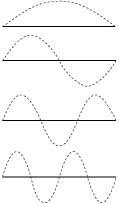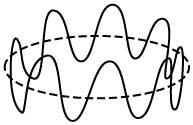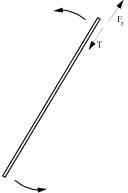Superstrings, revolution or dream?
According to this theory, which has attracted the attention of so many Nobel prizes, fractions would not be tiny points, but vibrant strings. In addition, our Universe would have four dimensions and ten: the three spatial, the temporal and other six that we do not see. What would I eat! Where are we going with all this?
Occasionally theories arise that question our previous beliefs and create revolutionary visions from new points of view. Most of them forget the silence, few others compete and only some of them are accepted by everyone.

Superstring theories also attracted the attention of the most prestigious scientists and learned at the best universities five years ago. So far they have been nothing more than a beautiful and desirable dream, but one day they could become a revolution. Therefore, it is preferable to be informed.
Historical evolution
The first appearance of the strings was a failure. In 1968, before quark theory appeared, scientists were concerned about hadron behavior (see “Basic fractions: the core of matter” Elhuyar Z. and T. Nº 55. January 1992). Sokena was a theory proposed to explain this behavior. According to this, the hadrons were not specific fractions, but spinning ropes. Even when Quarke's model proved its solidity, they tried to explain that string theories were discarded, that is, they were not always within the hadrons and never free (see chart).
All in vain; in 1974 quantum chromodynamics (QCD) expanded and accepted, leaving aside proposals on strings.
However, aware that some sciences asked for a special fraction of string theories, he went ahead. This special piece had the characteristics of gravitation and was thought to use the strings to explain gravitation. In 1980, they also applied a supersymmetry that exchanges all fractions, creating theories about superstrings. Supersymmetry unites fermions and bosons working in nature. Therefore, the theory of superropes would make reality, as never before, the greater unity of the laws of physics.
By 1986, the entire scientific community (with some exceptions) was very interested in superstrings.
What is the value of the superstrings?
Quantum mechanics vs general relativity
XX. The fact that the two foundations of 20th century physics, the theory of relativity and quantum mechanics, are useful and incompatible, has always provoked a concern among scientists.
Both theories are correct in areas of habitual use. Problems appear within walking distance, 10-35 m. On the one hand, to apply quantum mechanics to the gravitational field one must recognize that the spatio-temporal curvature is very small, since otherwise there would be infinite absurd eventres. But on the other hand, quantum mechanics claims the uncertainty of energy, and as mass and energy are the same, the uncertainty of energy materializes through the spontaneous generation of imaginary fractions in vacuum.
If the distance is less than 10-35 m, the energy (and its uncertainty) is so great that, according to general relativity, virtual black holes are created. And as we know, black holes have a very large curvature. Therefore, we can consider space as very curved at these distances, but, as we have said at the beginning, if the curvature is large, the solutions of quantum mechanics are infinite absurdities.
This is therefore the XX. The contradiction of 20th century physics: both the Theory of Relativity and Quantum Mechanics are correct in most applications (astronomy and local microelectronics), but at a small distance one of the two theories (or both) is wrong.
Scientists believe they can have a solution on the superropes to release this hard knot.
Vibrating strings

Why are the above-mentioned infinite estimates produced? Because fractions were considered points, that is, without dimensions. The problem is like when something is divided by zero. The strings, however, have a dimension (length) in which the infinite disappear.
According to the superstring theory, therefore, all the basic fractions are the sokas. In addition, a rope can vibrate in several ways (see figure 1). Each of these states of vibration would correspond to a fraction of different mass. That is, the difference between two known fractions is the state of vibration. Greater energy, greater mass and state of vibration. On the other hand, according to the most accepted cases, the strings would be closed (see figure 2).
If it is true, has this said that the “standard model” of basic fractions is wrong? Not much less. Remember that Einstein's mechanics did not deny that of Newton, but extended it, that is, Newton's mechanics was the special and restricted case of another more general, that of Einstein.
The current situation is the same. Fractions “at great distances” seem to be punctual, have a punctual activity and the standard model is perfectly correct. Within walking distance (10-35 m), however, we will see that fractions are truly vibrating rope rings and another surprise.
10 dimensions
Superstring theory requires that our Universe have 10 dimensions. The solution to overcome this obstacle is as follows: four dimensions (three spatial and temporal) are those we perceive daily, and the other six dimensions are framed in a small ball. Thus, a point of space is actually a semidimensional ball collected at 10-35 m. The measurement is so small that we cannot see other dimensions.
Admitting again that the Universe has four dimensions over great distances, there is no mistake. But once we descend to 10-35 m, we would notice the 10 dimensions.
And is it true?
The new conditions are that the fraction has strings and that the Universe has 10 dimensions. What have we won in return?
First, eliminate the contradictions between the Theory of Relativity and Quantum Mechanics. Secondly, that all different fractions and forces appear in a single model, that is, that all nature be reduced to a few laws.
But for those who are against the superropes, instead, this theory has shown nothing and does not propose affirmative experiments. Its main characteristic is its beauty and, apart from it, they say that it is nothing more than a retolica of the people who dream.
The latter have some reason. In fact, the contributions of the theory are available for 10-35 m, but access to that distance is totally impossible with the current instrumental, that is, there is no way to experiment.
However, we always need to know more about our world, and if this theory is exhausted, we need another. Also, if it were correct, we would earn more than lose. So, despite dreaming, many scientists have begun to exploit the line of superropes. Time has the word.
Defeat at the origin of the strings

When the strings appeared, they tried to explain the structure of the hadrons. For this, they said that the hadrons were spinning ropes. As the rope rotates, the length lengthens. When the length is sufficient for the ends to move with the speed of light, the centrifugal force assimilates the tension. This model, however, was wrong. The quark model was imposed and the string model was rejected.
When it was discovered that the hadrons were composed of quarkes, they were used to explain the rejection of the strings. As we know, the quarks cannot get out of the hadrons and upon falling a inn is created. The string theories explained it like this:

The quarkas are the ends of the strings (a), in the size of the hadrons the strong force (identified with the string tension) is small (b), but if we try to compare it appears a huge force (c). And if we release the quarca (that is, we break the rope) a new hadron and meson (d) appears. This second model also had to be discarded when Quantum Chromodynamics (QCD) appeared.





